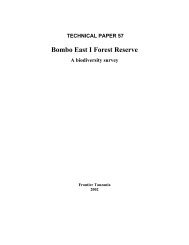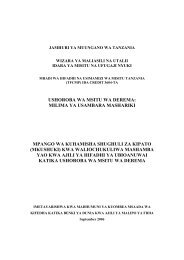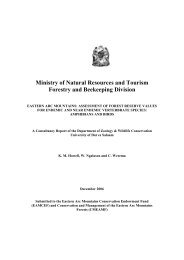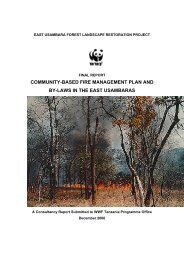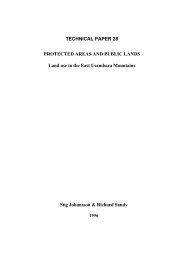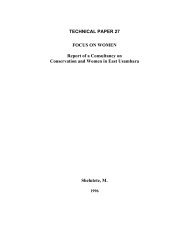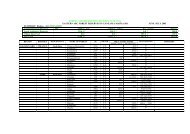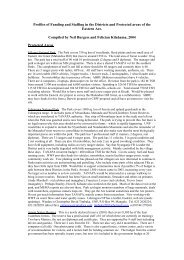Butterfly Farming in the East Usambara Mountains - Eastern Arc ...
Butterfly Farming in the East Usambara Mountains - Eastern Arc ...
Butterfly Farming in the East Usambara Mountains - Eastern Arc ...
You also want an ePaper? Increase the reach of your titles
YUMPU automatically turns print PDFs into web optimized ePapers that Google loves.
utterflies is stronger than demand for butterfly species from o<strong>the</strong>r areas of <strong>the</strong> world where<br />
butterfly farm<strong>in</strong>g is more common. 2<br />
2.1.3 Seasonality of Market<br />
The project will mediate <strong>the</strong> effects of seasonality <strong>in</strong> <strong>the</strong> market by prepar<strong>in</strong>g farmers for periods<br />
of low sales, sell<strong>in</strong>g dead stock for which <strong>the</strong>re is no season, and by support<strong>in</strong>g <strong>the</strong> creation of a<br />
domestic display that will provide demand for butterfly pupae dur<strong>in</strong>g <strong>the</strong> nor<strong>the</strong>rn hemisphere’s<br />
w<strong>in</strong>ter.<br />
2.2 Shipp<strong>in</strong>g and Payments<br />
2.2.1 Communicat<strong>in</strong>g with Buyers<br />
Email is by far <strong>the</strong> cheapest and most reliable form of communication <strong>in</strong> Tanzania, and is <strong>the</strong><br />
method that <strong>the</strong> Amani <strong>Butterfly</strong> Project uses to communicate with all of its potential buyers.<br />
Once sales beg<strong>in</strong>, buyers will mail an order form available on <strong>the</strong> Internet to <strong>the</strong> project staff.<br />
2.2.2 Shipp<strong>in</strong>g<br />
The ability to ship to <strong>the</strong> market quickly is crucial for butterfly farm<strong>in</strong>g. If shipments are delayed<br />
by more than one or two days, many pupae will hatch <strong>in</strong> <strong>the</strong> shipp<strong>in</strong>g boxes before <strong>the</strong>y have<br />
reached <strong>the</strong>ir f<strong>in</strong>al dest<strong>in</strong>ation. Ideally, shipments should reach <strong>the</strong>ir f<strong>in</strong>al dest<strong>in</strong>ations <strong>in</strong> 5 days<br />
or less. The project plans to ship butterfly pupae <strong>in</strong> Styrofoam l<strong>in</strong>ed cardboard boxes via DHL.<br />
The DHL head office <strong>in</strong> Dar es Salaam has <strong>in</strong>dicated that it will be possible for <strong>the</strong> project to<br />
meet <strong>the</strong>ir courier bus from Tanga <strong>in</strong> Muheza. DHL will <strong>the</strong>n meet <strong>the</strong> bus <strong>in</strong> Dar es Salaam and<br />
put <strong>the</strong> shipments on a plane <strong>the</strong> same night.<br />
2.2.3 Payments<br />
The project will use electronic bank transfers to receive payments from overseas. The project’s<br />
bank account will be <strong>in</strong> Tanga at a bank capable of <strong>in</strong>ternational transfers. Once trust is built up<br />
between <strong>the</strong> project and regular buyers, <strong>the</strong> project’s work<strong>in</strong>g capital will allow <strong>the</strong> project to let<br />
buyers pay <strong>the</strong> project every three or four months, ra<strong>the</strong>r than after every shipment. This will<br />
save buyers money on electronic transfer fees.<br />
<strong>Butterfly</strong> farm<strong>in</strong>g groups will be paid based on <strong>the</strong> number of pupae <strong>the</strong>y provided each month.<br />
At first <strong>the</strong>y will be given 55% of <strong>the</strong> market price, which should total to 65% of project earn<strong>in</strong>gs<br />
once 15% shipp<strong>in</strong>g losses for which buyers are not charged are factored <strong>in</strong>. Funds will be<br />
transferred <strong>in</strong>to <strong>the</strong>ir bank accounts <strong>in</strong> Muheza on a monthly basis. To access <strong>the</strong>se funds, groups<br />
must hold meet<strong>in</strong>gs and present <strong>the</strong> project manager with <strong>the</strong> m<strong>in</strong>utes of <strong>the</strong> meet<strong>in</strong>g. To <strong>in</strong>sure<br />
this process is followed, <strong>the</strong> project will hold <strong>the</strong> bankbooks for each group and <strong>the</strong> groups’<br />
signatories will come to collect <strong>the</strong>ir bankbooks with <strong>the</strong> m<strong>in</strong>utes of <strong>the</strong>ir groups meet<strong>in</strong>g.<br />
The 7% development fund will reside <strong>in</strong> <strong>the</strong> Amani <strong>Butterfly</strong> Project Group’s bank account <strong>in</strong><br />
Tanga. The group’s executive committee manages this account. Funds will be transferred to this<br />
account on a monthly basis and records will be kept to <strong>in</strong>dicate <strong>the</strong> percentage of <strong>the</strong> fund that<br />
each village is entitled to.<br />
2 Slone et al. 1997 “A comparison of price, rarity and cost of butterfly specimens: Implications for <strong>the</strong> <strong>in</strong>sect trade and for<br />
habitat conservation” Ecological Economics 21: 77-85<br />
31



